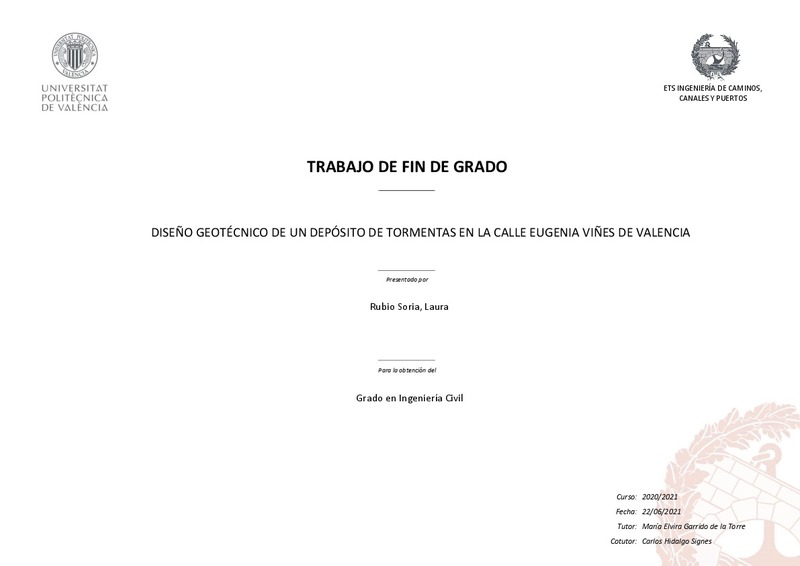|
Resumen:
|
[ES] DESCRIPCIÓN
El presente trabajo trata de resolver los problemas geotécnicos derivados de la construcción de un depósito de tormentas en una parcela de la calle Eugenia Viñes de València. La zona se enclava en el ...[+]
[ES] DESCRIPCIÓN
El presente trabajo trata de resolver los problemas geotécnicos derivados de la construcción de un depósito de tormentas en una parcela de la calle Eugenia Viñes de València. La zona se enclava en el abanico aluvial de la desembocadura del rio Turia, caracterizado por una gran variabilidad -horizontal y vertical- en las características del terreno. Esto unido al entorno urbano condiciona la construcción de cualquier tipo de estructura enterrada que puede afectar a edificios y calzadas del entorno. En consecuencia, es muy importante un riguroso estudio del suelo a fin de ubicar el depósito en una zona lo suficientemente homogénea como para garantizar su estabilidad frente a una deformación excesiva del terreno. Por otro lado, dada la cercanía a la costa, a buen seguro el depósito se apoyará en el terreno por debajo de la capa freática, se plantean importantes problemas: por un lado, la ejecución de la excavación con toda probabilidad requerirá del diseño de elementos de contención como tablestacas o muros-pantallas y, por otro lado, será necesario estudiar los fenómenos de sifonamiento y/o levantamiento de fondo, así como la flotabilidad de la estructura.
Este trabajo requiere un estudio riguroso de los esfuerzos que se transmitirán al terreno y los cambios tensionales a que dará lugar la construcción del depósito. El procedimiento que se va seguir para comprobar la seguridad de la estructura, es el basado en el concepto de estados límite. Los estudios previos permitirán establecer los condicionantes geológicos, topográficos y sísmicos. La capacidad del depósito de tormentas será un dato de partida. A continuación, se determinarán las características geomecánicas del terreno, en base a los resultados de las campañas de ensayos de campo y laboratorio, que serán facilitadas por los tutores. Con estos datos se decidirá la geometría más conveniente para el depósito y la ubicación más adecuada dentro de la parcela. A continuación, se realizarán las siguientes comprobaciones de seguridad: estado límite último de hundimiento y estados límites de servicio de deformaciones excesivas y flotabilidad. Por último, se analizará la excavabilidad del terreno y se definirá el método de contención más adecuado para la construcción de la mencionada estructura.
[-]
[EN] This work attempts to solve the geotechnical problems derived from the construction of a storm tank on a plot of land in Eugenia Viñes street in Valencia. The area is located in the alluvial fan at the mouth of the ...[+]
[EN] This work attempts to solve the geotechnical problems derived from the construction of a storm tank on a plot of land in Eugenia Viñes street in Valencia. The area is located in the alluvial fan at the mouth of the Turia river, characterised by a great variability -horizontal and vertical- in the characteristics of the terrain. This, together with the urban environment, conditions the construction of any type of buried structure that may affect buildings and roadways in the surrounding area. Consequently, it is very important to carry out a rigorous study of the soil in order to locate the tank in a sufficiently homogeneous area to guarantee its stability in the event of excessive deformation of the ground. On the other hand, given the proximity to the coast, the tank will certainly rest on the ground below the water table, and this raises important problems: on the one hand, the excavation will most probably require the design of containment elements such as sheet piles or screen walls and, on the other hand, it will be necessary to study the phenomena of siphoning and/or rising of the bottom, as well as the buoyancy of the structure.
This work requires a rigorous study of the stresses that will be transmitted to the ground and the stress changes that will result from the construction of the reservoir. The procedure to be followed to check the safety of the structure is based on the concept of limit states. Preliminary studies will establish the geological, topographical, and seismic constraints. The capacity of the storm reservoir will be a starting point. The geomechanical characteristics of the terrain will then be determined, based on the results of the field and laboratory test campaigns, which will be provided by the tutors. With these data, the most suitable geometry for the reservoir and the most suitable location within the plot will be decided. The following safety checks will then be carried out: ultimate limit state of subsidence and serviceability limit states of excessive deformation and buoyancy. Finally, the excavability of the land will be analysed and the most suitable containment method for the construction of the structure will be defined.
[-]
|







